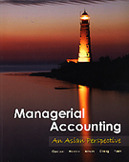-
出版商:
Independently published
-
出版日期:
2018-06-05
-
售價:
$940
-
貴賓價:
9.5 折
$893
-
語言:
英文
-
頁數:
143
-
裝訂:
Paperback
-
ISBN:
1983014729
-
ISBN-13:
9781983014727
商品描述
The objective of this research project is to describe the factory of the future as projected by the Cost Management System (CMS) developed by the Consortium for Advanced Management International (CAM-I), formerly Computer-Aided Manufacturing -- International, Inc., and its sponsors. The project will also address the implications the system has on Cost Improvement Curve Theory, Cost/Schedule Control Systems Criteria, and the movement toward Total Quality, which have now evolved into Earned Value Management. This project was completed before the new terminology was adopted, although the same principles will still apply. I produced this project because at the time I was the Air Force representative to CAM-I, had been the Comptroller Representative and had a hand in editing and discussing Cost Accounting for Today’s Advanced Manufacturing, the CAM-I/CMS Conceptual Design, which is the precursor to Activity Accounting. The project begins with a brief history of the CMS, addressing the four phases of the effort… The second chapter discusses the factory of the future and Cost Improvement Curve Theory. It is divided into two sections. The factory of the future will be described using the generic activities found in the CMS Engineering/Manufacturing Functional Model. These activities are applied to the five manufacturing environments using the Manufacturing Processes Profile. The discussion on Cost Improvement Curve Theory presents two viewpoints on the causes of learning, describing how learning might occur in each of the manufacturing environments. The third chapter addresses CMS Cost Information features. It contains five sections. In the first four sections a different part of a company’s cost information system will be described. The four parts are life cycle cost management, activity accounting, factory floor information and cost and performance measurement. In each of these sections CMS concepts are discussed, the CAM-I System Design Module is described and application of the Cost/Schedule Control Systems Criteria (Earned Value Management) is discussed. The last section summarizes Criteria (EVM) application. The fourth chapter addresses the CMS and quality. It contains two sections. The first section describes CMS tools which relate to quality. These are Activity Accounting, the Quality Function, Quality Management and Investment Management. The second section describes the CMS role in change, both rule and cultural. Appendix One is the C/SCSC Checklist, as applied to the CMS. Note that some updating may be required to update to EVM protocols. It should still be useful as a cross check to criteria application between the various modules. Appendix Two is a copy of the project briefing. The project utilized the CMS¬ Conceptual Design and the CMS System Design deliverables rather heavily. This was necessary because of the nature of the project as a description and discussion of these sources. For ease of reading quotation marks and indention are omitted. Suffice it to say that much of the-description found in this project is lifted directly from the data sources (especially some of the charts). These sources, as well as the government publications utilized, are listed in Appendix Tree. This project is a useful a primer on the automated factory of the future and on the CAM-I CMS. The CMS will likely be the industry standard in cost estimation, planning and control. The discussion found in Chapter 3 will aid Demonstration/Review Teams in validating contractor Earned Value systems which utilize a CMS. Benefits from participation in the CMS are greater visibility of technology improvement costs now buried in overhead, more accurate product cost, elimination of waste through tracking of non-value added cost provided through activity accounting, awareness)of change in defense contractor systems and the ”state of the art” and greater defense contractor participation in the CMS effort.
商品描述(中文翻譯)
本研究專案的目標是描述未來工廠,這是由國際先進管理聯盟(Consortium for Advanced Management International,簡稱 CAM-I)所開發的成本管理系統(Cost Management System,簡稱 CMS)所預測的,CAM-I 之前名為電腦輔助製造國際公司(Computer-Aided Manufacturing -- International, Inc.),以及其贊助者。該專案還將探討該系統對成本改善曲線理論(Cost Improvement Curve Theory)、成本/進度控制系統標準(Cost/Schedule Control Systems Criteria)以及向全面品質管理(Total Quality)邁進的影響,這些現在已演變為賺取價值管理(Earned Value Management)。該專案在新術語被採用之前完成,儘管相同的原則仍然適用。我之所以製作這個專案,是因為當時我是空軍代表參加 CAM-I,曾擔任財務主管代表,並參與編輯和討論《當前先進製造的成本會計》(Cost Accounting for Today’s Advanced Manufacturing)以及 CAM-I/CMS 概念設計,這是活動會計(Activity Accounting)的前身。該專案以 CMS 的簡要歷史開始,涵蓋了該工作的四個階段……第二章討論未來工廠和成本改善曲線理論。這一章分為兩個部分。未來工廠將使用 CMS 工程/製造功能模型中的通用活動進行描述。這些活動應用於五種製造環境,使用製造過程概況(Manufacturing Processes Profile)。對成本改善曲線理論的討論提出了兩種對學習原因的觀點,描述了學習如何可能在每個製造環境中發生。第三章探討 CMS 成本信息特徵。該章包含五個部分。在前四個部分中,將描述公司成本信息系統的不同部分。這四個部分分別是生命週期成本管理、活動會計、工廠現場信息以及成本和績效測量。在這些部分中,討論了 CMS 概念,描述了 CAM-I 系統設計模組,並探討了成本/進度控制系統標準(賺取價值管理)的應用。最後一部分總結了標準(EVM)的應用。第四章探討 CMS 和品質。該章包含兩個部分。第一部分描述與品質相關的 CMS 工具,包括活動會計、品質功能、品質管理和投資管理。第二部分描述 CMS 在變革中的角色,包括規則和文化方面。附錄一是 C/SCSC 檢查表,應用於 CMS。請注意,可能需要一些更新以符合 EVM 協議。它仍然應該作為不同模組之間標準應用的交叉檢查。附錄二是專案簡報的副本。該專案在很大程度上利用了 CMS 概念設計和 CMS 系統設計的交付成果。這是必要的,因為該專案的性質是對這些來源的描述和討論。為了便於閱讀,省略了引號和縮排。可以說,該專案中找到的許多描述直接來自數據來源(特別是一些圖表)。這些來源以及所使用的政府出版物列在附錄三中。該專案是未來自動化工廠和 CAM-I CMS 的有用入門書。CMS 可能會成為成本估算、規劃和控制的行業標準。第三章中的討論將幫助示範/審查小組驗證使用 CMS 的承包商賺取價值系統。參與 CMS 的好處包括更清晰的技術改進成本(目前埋藏在間接費用中)、更準確的產品成本、通過活動會計追蹤非增值成本來消除浪費、對國防承包商系統變化的認識以及“最先進”的狀態,以及國防承包商在 CMS 工作中的更大參與。





















